What is Dridex?
The Dangers of Dridex: Understanding and Protecting Against a Notorious Malware
Dridex is a highly sophisticated type of malware that specifically targets the financial sector. This strain of banking trojan has evolved into an aggressive malware tool. Since it was first discovered in 2011, cybersecurity professionals and antivirus companies in the world have been contending with Dridex, also known as Cridex or Bugat. Despite ongoing efforts to suppress this peril, the malware has succeeded in stealing millions of dollars and financial information.Dridex was developed and operated by a cybercrime organization known as "Evil Corp" led by a Russian hacker. This structured malware operates in a way that allows it to steal banking credentials and personal data which it transmits back to the infrastructure controlled by the cybercriminals. It then uses this information to gain unlawful access to victim's bank accounts, perpetrating fraudulent financial transactions.
Dridex's modus operandi involves the use of maliciously crafted Excel spreadsheets or Word documents sent through phishing emails to potential victims. Alternatively, drive-by downloads are often perpetuated when an unsuspecting internet user visits a compromised website. Opening these seemingly harmless files or even clicking on the embedded macros in these documents often triggers the installation of the malware.
Once installed, Dridex searches for vital information, focusing mainly on internet banking login details and personal financial data. By lying dormant and gathering valuable information, this highly evasive malware behaves like a conventional Trojan horse. Its synthetically intelligent nature allows it to bypass many antivirus defenses and adapt itself to new environments.
The strain is largely spreading due to its ability to self-propagate via peer-to-peer networks. It manifests in malicious spam campaigns that follow a botnet controlled distribution model. The framework allows cybercriminals to leverage the economies of scale and volume, expanding the malware distribution networks as quickly as possible across different geographical locations.
Dridex has garnered significant attention from the cybersecurity community and law enforcement agencies worldwide due to its sophistication and repercussions of its attacks. It is characterized by its operability in various computing environments and evasive tactics to avoid detection and elimination. The dynamic development of the fare and the ability of its developers to adjust and vary its tactics truly embody the ongoing cyber criminal-versus-defense specialists' contest.
Several anti-Dridex efforts have taken place over the years. Key amongst them was malware white-hat hackers in 2015, teaming up with law enforcement agencies. Despite this operation, shutting down many of its vital nodes in its infrastructure, Dridex continues to proliferate.
Besides, IT threat mitigation specialists and cybersecurity pros have been working relentlessly to ascertain new versions of the fare and their propagation methods. This analysis assists in fine-tuning antivirus software suites and other defense infrastructure to better detect and combat the Trojan. Consequently, they develop more robust control strategies, continually adapting to remodeled attack advanced mechanisms.
Looking into the future, as Dridex and its derivatives continue to pose threats to cybersecurity, it underscores the importance of maintaining updated cybersecurity practices for everyone. While several measures are being taken by corporations, banking institutions, antivirus institutions, and governments to mitigation, there's a great need for all internet users to sustain a culture of cyber hygiene that encompasses regular updating of antivirus databases, avoiding suspicious downloads and email attachments, and securing their internet banking details.
The fight against Dridex is still far from over, given its distinctive mutating capability. A holistic approach, merging advanced cybersecurity techniques with user education, is crucial to stymie its effects. Meanwhile, up-to-date antivirus software, a cautious online approach, and robust cybersecurity practices for individuals and corporations remain vital shields in this ongoing battle.

Dridex FAQs
What is Dridex?
Dridex is a type of banking Trojan malware that primarily targets financial institutions. It is designed to steal sensitive information such as login credentials, banking information, and personal data.How does Dridex infect systems?
Dridex usually spreads through attachments in phishing emails that appear to be legitimate. Once the attachment is opened, the malware gains access to the system and begins to steal sensitive information.What are the consequences of a Dridex infection?
A Dridex infection can have serious consequences for individuals and organizations, particularly in terms of financial loss and compromised personal information. The malware can compromise bank accounts, steal credit card information, and even lead to identity theft.How can I protect my system from Dridex?
Protecting your system from Dridex requires good cybersecurity practices, such as installing and regularly updating antivirus software, using complex passwords, and being cautious when opening email attachments. Additionally, it's important to educate yourself and your employees about phishing emails and how to identify them.| | A | | | B | | | C | | | D | | | E | | | F | | | G | | | H | | | I | | | J | | | K | | | L | | | M | |
| | N | | | O | | | P | | | Q | | | R | | | S | | | T | | | U | | | V | | | W | | | X | | | Y | | | Z | |
| | 1 | | | 2 | | | 3 | | | 4 | | | 7 | | | 8 | | |||||||